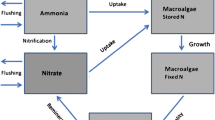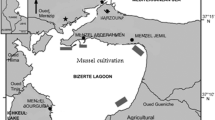Abstract
Bivalve cultivation, in single cultivation or in polyculture (including integrated multitrophic aquaculture; IMTA), is generally limited to eutrophic waters. We carried out a modeling study to test if, under meso- and oligotrophic conditions, depth could be a key factor for bivalve productivity associated to IMTA and other polyculture strategies. We applied the model Farm Aquaculture Resource Management (FARM) at three strata of the water column in two coastal fish farm areas in the Mediterranean Sea, using water column variables sampled seasonally to estimate the potential mussel production. According to FARM, mussel production was high in both areas and, in some cases, almost doubled when mussels were cultured below 25-m depth compared to shallower levels. Phytoplankton abundance is expected to notably influence mussel production compared to particulate organic matter. Thus, in meso- and oligotrophic stratified waters, where chlorophyll maximum is relatively deep, depth can be a key factor for the productivity of mussel cultivation. The obtained results could help to maximize the production of suspension-feeding bivalve cultivation and, therefore, the expansion and development of sustainable aquaculture in non-eutrophic marine waters.


Similar content being viewed by others
References
Angel D, Freeman S (2009) Integrated aquaculture (INTAQ) as a tool for an ecosystem approach to the marine farming sector in the Mediterranean Sea. Integrated mariculture: a global review, 133–183
Barrington K, Chopin T, Robinson S (2009) Integrated multi-trophic aquaculture (IMTA) in marine temperate waters. Integrated mariculture: a global review. FAO Fisheries and Aquaculture Technical Paper 529:7–46
Black E, Blackburn M, Harrison G, Hoskins B, Methven J (2004) Factors contributing to the summer 2003 European heatwave. Weather 59:217–223
Callier MD, Weise AM, McKindsey CW, Desrosiers G (2006) Sedimentation rates in a suspended mussel farm (Great-Entry Lagoon, Canada): biodeposit production and dispersion. Mar Ecol Prog Ser 322:129–141
Costa-Pierce BA (2008) Ecological aquaculture: the evolution of the blue revolution. Wiley
Cranford PJ, Reid GK, Robinson SMC (2013) Open water integrated multi-trophic aquaculture: constraints on the effectiveness of mussels as an organic extractive component. Aquacult Environ Interact 4:163–173
Cullen JJ (2015) Subsurface chlorophyll maximum layers: enduring enigma or mystery solved? Annu Rev Mar Sci 7(7):207–239
Puertos del Estado (2016) Redes de boyas oceanográficas. Retrieved from: http://www.puertos.es/oceanografia_y_meteorologia/redes_de_medida/index.html
Denis L, Alliot E, Grzebyk D (1999) Clearance rate responses of Mediterranean mussels, Mytilus galloprovincialis, to variations in the flow, water temperature, food quality and quantity. Aquat Living Resour 12:279–288
Estrada M, Marrase C, Latasa M, Berdalet E, Delgado M, Riera T (1993) Variability of deep chlorophyll maximum characteristics in the northwestern Mediterranean. Mar Ecol Prog Ser 92:289–300
Fabres J, Calafat A, Sanchez-Vidal A, Canals M, Heussner S (2002) Composition and spatio-temporal variability of particle fluxes in the western Alboran Gyre, Mediterranean Sea. J Mar Syst 33:431–456
FAO (2013) Aquaculture Information and Statistics Service. 2011 FAO yearbook. FAO UN, Rome
FAO (2014) The state of world fisheries and aquaculture 2014. Food and Agricultural Organization of the United Nations, Rome
FAO (2016) Cultured Aquatic Species Information of Mytilus spp. Retrieved from: http://www.fao.org/fishery/culturedspecies/Mytilus_edulis/en
Ferreira JG, Hawkins AJS, Bricker SB (2007) Management of productivity, environmental effects and profitability of shellfish aquaculture—the FARM aquaculture resource management (FARM) model. Aquaculture 264:160–174
Filgueira R, Byron CJ, Comeau LA, Costa-Pierce B, Cranford PJ, Ferreira JG et al (2015) An integrated ecosystem approach for assessing the potential role of cultivated bivalve shells as part of the carbon trading system. Mar Ecol Prog Ser 518:281–287
Filgueira R, Guyondet T, Reid GK, Grant J, Cranford PJ (2017) Vertical particle fluxes dominate integrated multi-trophic aquaculture (IMTA) sites: implications for shellfish-finfish synergy. Aquaculture Environment Interactions 9:127–143
Gong X, Shi J, Gao HW, Yao XH (2015) Steady-state solutions for subsurface chlorophyll maximum in stratified water columns with a bell-shaped vertical profile of chlorophyll. Biogeosciences 12:905–919
Guyondet T, Comeau LA, Bacher C, Grant J, Rosland R, Sonier R, Filgueira R (2015) Climate change influences carrying capacity in a coastal embayment dedicated to shellfish aquaculture. Estuar Coasts 38:1593–1618
Holmer M (2010) Environmental issues of fish farming in offshore waters: perspectives, concerns and research needs. Aquaculture Environment Interactions 1:57–70
Holmer M, Wildish D, Hargrave B (2005) Organic enrichment from marine finfish aquaculture and effects on sediment biogeochemical processes. In: Hargrave BT (ed) Environmental effects of Marine finfish aquaculture, pp 181–206
Holmer M, Marba N, Diaz-Almela E, Duarte CM, Tsapakis M, Danovaro R (2007) Sedimentation of organic matter from fish farms in oligotrophic Mediterranean assessed through bulk and stable isotope (delta C-13 and delta N-15) analyses. Aquaculture 262:268–280
Holmyard J (2008) Potential for offshore mussel culture. Shellfish News 25:19–22
IPCC (2007) Climate change 2007: synthesis report. Cambridge University Press, Cambridge
Maar M, Bolding K, Petersen JK, Hansen JLS, Timmermann K (2009) Local effects of blue mussels around turbine foundations in an ecosystem model of Nysted off-shore wind farm, Denmark. J Sea Res 62:159–174
Maldonado M, Carmona MC, Echeverria Y, Riesgo A (2005) The environmental impact of Mediterranean cage fish farms at semi-exposed locations: does it need a re-assessment? Helgol Mar Res 59:121
Manca B, Burca M, Giorgetti A, Coatanoan C, Garcia MJ, Iona A (2004) Physical and biochemical averaged vertical profiles in the Mediterranean regions: an important tool to trace the climatology of water masses and to validate incoming data from operational oceanography. J Mar Syst 48:83–116
Martinez-Garcia E, Carlsson MS, Sanchez-Jerez P, Sánchez-Lizaso JL, Sanz-Lazaro C, Holmer M (2015) Effect of sediment grain size and bioturbation on decomposition of organic matter from aquaculture. Biogeochemistry 125:133–148
Myrand B, Guderley H, Himmelman JH (2000) Reproduction and summer mortality of blue mussels Mytilus edulis in the Magdalen Islands, southern Gulf of St. Lawrence. Mar Ecol Prog Ser 197:193–207
Navarrete-Mier F, Sanz-Lazaro C, Marin A (2010) Does bivalve mollusc polyculture reduce marine fin fish farming environmental impact? Aquaculture 306:101–107
Oguz T, Macias D, Garcia-Lafuente J, Pascual A, Tintore J (2014). Fueling plankton production by a meandering frontal jet: a case study for the Alboran Sea (Western Mediterranean). Plos One 9
Sanz-Lazaro C, Marin A (2011) Diversity patterns of benthic macrofauna caused by marine fish farming. Diversity 2:176–199
Sanz-Lazaro C, Sanchez-Jerez P (2017) Mussels do not directly assimilate fish farm wastes: shifting the rationale of integrated multi-trophic aquaculture to a broader scale. J Environ Manag 201:82–88
Schulte EH (1975) Influence of algal concentration and temperature on the filtration rate of Mytilus edulis. Mar Biol 30:331–341
Silva C, Ferreira JG, Bricker SB, Del Valls TA, Martin-Diaz ML, Yanez E (2011) Site selection for shellfish aquaculture by means of GIS and farm-scale models, with an emphasis on data-poor environments. Aquaculture 318:444–457
Soto D (2009) Integrated mariculture: a global review. Food and Agriculture Organization of the United Nations (FAO)
Tang Q, Zhang J, Fang J (2011) Shellfish and seaweed mariculture increase atmospheric CO2 absorption by coastal ecosystems. Mar Ecol Prog Ser 424:97–104
Theede H (1962) Experimentelle Untersuchungen über die Filtrationsleistung der Miesmuschel Mytilus edulis L. Christian-Albrechts-Universitaet
Troell M, Joyce A, Chopin T, Neori A, Buschmann AH, Fang JG (2009) Ecological engineering in aquaculture—potential for integrated multi-trophic aquaculture (IMTA) in marine offshore systems. Aquaculture 297:1–9
Ward JE, Shumway SE (2004) Separating the grain from the chaff: particle selection in suspension- and deposit-feeding bivalves. J Exp Mar Biol Ecol 300:83–130
Acknowledgements
We are grateful to the comments of two anonymous reviewers that helped to improve the manuscript and Allison Moore for checking the English.
Funding
This work has been funded by the project SUMERGI+DOS (CTAQUA1-12I) from the Centro Tecnológico de Acuicultura de Andalucía, the project CGL2015-70136-R from the Ministerio de Economía y Competitividad y Ciencia from Spain, and a Juan de la Cierva research grant to C. S. (Ref. JCI-2012-12413) from the Ministerio de Economía y Competitividad y Ciencia from Spain.
Author information
Authors and Affiliations
Corresponding author
Additional information
Highlights
- Depth may be a key factor for the cultivation of bivalves in stratified non-eutrophic waters
- Mussel production can be almost doubled when cultured at depths where feeding conditions of the cultivation are maximized.
- This study can help the implementation of integrated multitrophic aquaculture (IMTA) and other polyculture strategies in non-eutrophic areas.
Rights and permissions
About this article
Cite this article
Sanz-Lazaro, C., Fernandez-Gonzalez, V., Arechavala-Lopez, P. et al. Depth matters for bivalve culture in integrated multitrophic aquaculture (IMTA) and other polyculture strategies under non-eutrophic conditions. Aquacult Int 26, 1161–1170 (2018). https://doi.org/10.1007/s10499-018-0276-9
Received:
Accepted:
Published:
Issue Date:
DOI: https://doi.org/10.1007/s10499-018-0276-9




